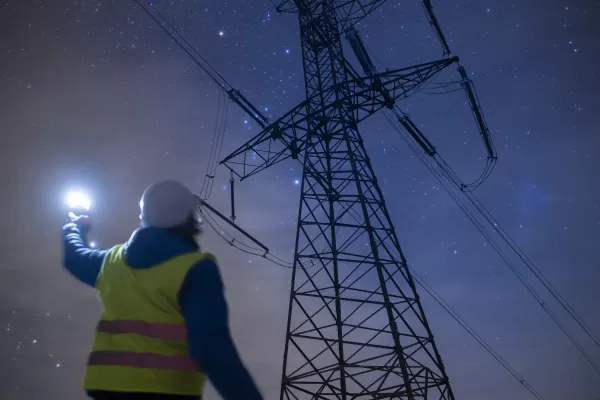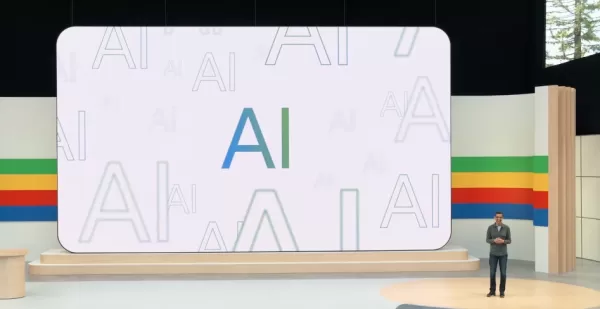Google Believes AI Can Simplify Electrical Grid's Bureaucracy

The tech world is buzzing with concern over a potential power crisis, fueled by the skyrocketing demand from AI. Yet, amidst this worry, there's a glimmer of hope: a massive amount of new power capacity, measured in terawatts, is just waiting to be connected to the grid. The key? Cutting through the red tape that's holding things back.
Across the U.S., grid operators are grappling with backlogs, but none more so than PJM, which oversees electricity distribution in the mid-Atlantic states, Ohio, and eastern Kentucky. The situation there is particularly dire.
Google and PJM: Teaming Up with AI
In a move that could speed up the process, Google and PJM, along with Alphabet's innovative project Tapestry, have joined forces. Their goal? To harness AI to streamline the application process for connecting new power sources to the grid. This collaboration will focus on enhancing data verification and using centralized planning tools to help PJM better incorporate variable energy sources like renewables into the mix.
The Race for Power
The AI boom has sparked a mad dash among tech giants to secure electricity. Companies like Amazon, Google, Meta, and Microsoft are not just investing in nuclear power but also gobbling up solar energy at a rapid pace. Yet, the bottleneck in connecting new power sources to the grid remains a thorny issue, especially when it comes to ensuring that data centers don't run out of juice.
According to the Lawrence Berkeley Lab, there's a staggering 2.6 terawatts of power capacity nationwide awaiting approval. That's double the total output of all U.S. power plants today.
PJM's Overwhelming Queue
PJM's situation is the most extreme, with over 3,000 active requests to connect a whopping 286.7 gigawatts of capacity. The backlog has become so unmanageable that PJM halted new connection applications in 2022 and won't even look at new ones until mid-2026.
Renewables Caught in the Slow Lane
The sluggish approval process hits renewable energy projects the hardest. Nationally, over 1 terawatt of solar and storage capacity is stuck in limbo, waiting for the green light to connect to the grid. Even in PJM's region, which isn't typically known for its renewable energy push, solar and storage dominate the queue, with only 2.4% of applications coming from natural gas plants.
Historically, PJM's grid has been powered by fossil fuels, with natural gas plants taking over from coal thanks to the fracking boom. Recently, PJM introduced a new approval process that some argue gives fossil fuel projects an unfair advantage over renewables.
A Step Towards a Cleaner Grid?
As part of their partnership announcement, PJM's Executive Vice President Aftab Khan emphasized that the grid would remain "fuel agnostic," according to E&E News. On the other hand, Google's spokesperson Amanda Peterson Corio reaffirmed their commitment to decarbonizing their electricity use.
This collaboration between Google and PJM could be a pivotal step in not only addressing the power shortage but also in paving the way for a more sustainable energy future.
Related article
 Google's Latest Gemini AI Model Shows Declining Safety Scores in Testing
Google's internal testing reveals concerning performance dips in its latest AI model's safety protocols compared to previous versions. According to newly published benchmarks, the Gemini 2.5 Flash model demonstrates 4-10% higher rates of guideline vi
Google's Latest Gemini AI Model Shows Declining Safety Scores in Testing
Google's internal testing reveals concerning performance dips in its latest AI model's safety protocols compared to previous versions. According to newly published benchmarks, the Gemini 2.5 Flash model demonstrates 4-10% higher rates of guideline vi
 Google's Stitch AI Simplifies App Design Process
Google Unveils Stitch AI Design Tool at I/O 2025Google introduced Stitch, its revolutionary AI-powered interface design tool, during the keynote at Google I/O 2025. This innovative solution transforms natural language prompts or reference images into
Google's Stitch AI Simplifies App Design Process
Google Unveils Stitch AI Design Tool at I/O 2025Google introduced Stitch, its revolutionary AI-powered interface design tool, during the keynote at Google I/O 2025. This innovative solution transforms natural language prompts or reference images into
 Google Introduces AI-Powered Tools for Gmail, Docs, and Vids
Google Unveils AI-Powered Workspace Updates at I/O 2025During its annual developer conference, Google has introduced transformative AI enhancements coming to its Workspace suite, fundamentally changing how users interact with Gmail, Docs, and Vids. T
Comments (9)
0/200
Google Introduces AI-Powered Tools for Gmail, Docs, and Vids
Google Unveils AI-Powered Workspace Updates at I/O 2025During its annual developer conference, Google has introduced transformative AI enhancements coming to its Workspace suite, fundamentally changing how users interact with Gmail, Docs, and Vids. T
Comments (9)
0/200
![JuanCarter]() JuanCarter
JuanCarter
 September 17, 2025 at 4:30:28 PM EDT
September 17, 2025 at 4:30:28 PM EDT
Finally someone's tackling the paperwork nightmare! If AI can make my electric bill less confusing that'd be a win. But can it also explain why my toaster uses more power than my fridge? 😅


 0
0
![KevinWalker]() KevinWalker
KevinWalker
 August 10, 2025 at 3:00:59 PM EDT
August 10, 2025 at 3:00:59 PM EDT
AI simplifying the grid sounds cool, but can it really cut through all that red tape? 🤔 I’m curious if this’ll make energy cheaper or just make Google richer.


 0
0
![AnthonyMiller]() AnthonyMiller
AnthonyMiller
 August 4, 2025 at 2:01:00 AM EDT
August 4, 2025 at 2:01:00 AM EDT
AI simplifying the grid's bureaucracy sounds promising, but can it really handle the red tape? Excited to see if Google pulls this off! 🚀


 0
0
![DouglasMartin]() DouglasMartin
DouglasMartin
 July 23, 2025 at 1:31:54 AM EDT
July 23, 2025 at 1:31:54 AM EDT
It's wild how AI could untangle the grid's red tape! The idea of terawatts just sitting there is crazy—hope Google’s onto something big here. 🌩️


 0
0
![AnthonyGonzález]() AnthonyGonzález
AnthonyGonzález
 April 22, 2025 at 7:57:37 PM EDT
April 22, 2025 at 7:57:37 PM EDT
L'IA pour simplifier le réseau électrique ? Fascinant ! Mais j’espère qu’on pensera aussi à la cybersécurité. 🔒


 0
0
![BenWalker]() BenWalker
BenWalker
 April 22, 2025 at 4:25:13 PM EDT
April 22, 2025 at 4:25:13 PM EDT
ИИ упростит электросети? Звучит круто! Но как бы не получилось, что мы зависим от машин больше, чем надо. 😬


 0
0

The tech world is buzzing with concern over a potential power crisis, fueled by the skyrocketing demand from AI. Yet, amidst this worry, there's a glimmer of hope: a massive amount of new power capacity, measured in terawatts, is just waiting to be connected to the grid. The key? Cutting through the red tape that's holding things back.
Across the U.S., grid operators are grappling with backlogs, but none more so than PJM, which oversees electricity distribution in the mid-Atlantic states, Ohio, and eastern Kentucky. The situation there is particularly dire.
Google and PJM: Teaming Up with AI
In a move that could speed up the process, Google and PJM, along with Alphabet's innovative project Tapestry, have joined forces. Their goal? To harness AI to streamline the application process for connecting new power sources to the grid. This collaboration will focus on enhancing data verification and using centralized planning tools to help PJM better incorporate variable energy sources like renewables into the mix.
The Race for Power
The AI boom has sparked a mad dash among tech giants to secure electricity. Companies like Amazon, Google, Meta, and Microsoft are not just investing in nuclear power but also gobbling up solar energy at a rapid pace. Yet, the bottleneck in connecting new power sources to the grid remains a thorny issue, especially when it comes to ensuring that data centers don't run out of juice.
According to the Lawrence Berkeley Lab, there's a staggering 2.6 terawatts of power capacity nationwide awaiting approval. That's double the total output of all U.S. power plants today.
PJM's Overwhelming Queue
PJM's situation is the most extreme, with over 3,000 active requests to connect a whopping 286.7 gigawatts of capacity. The backlog has become so unmanageable that PJM halted new connection applications in 2022 and won't even look at new ones until mid-2026.
Renewables Caught in the Slow Lane
The sluggish approval process hits renewable energy projects the hardest. Nationally, over 1 terawatt of solar and storage capacity is stuck in limbo, waiting for the green light to connect to the grid. Even in PJM's region, which isn't typically known for its renewable energy push, solar and storage dominate the queue, with only 2.4% of applications coming from natural gas plants.
Historically, PJM's grid has been powered by fossil fuels, with natural gas plants taking over from coal thanks to the fracking boom. Recently, PJM introduced a new approval process that some argue gives fossil fuel projects an unfair advantage over renewables.
A Step Towards a Cleaner Grid?
As part of their partnership announcement, PJM's Executive Vice President Aftab Khan emphasized that the grid would remain "fuel agnostic," according to E&E News. On the other hand, Google's spokesperson Amanda Peterson Corio reaffirmed their commitment to decarbonizing their electricity use.
This collaboration between Google and PJM could be a pivotal step in not only addressing the power shortage but also in paving the way for a more sustainable energy future.
 Google's Stitch AI Simplifies App Design Process
Google Unveils Stitch AI Design Tool at I/O 2025Google introduced Stitch, its revolutionary AI-powered interface design tool, during the keynote at Google I/O 2025. This innovative solution transforms natural language prompts or reference images into
Google's Stitch AI Simplifies App Design Process
Google Unveils Stitch AI Design Tool at I/O 2025Google introduced Stitch, its revolutionary AI-powered interface design tool, during the keynote at Google I/O 2025. This innovative solution transforms natural language prompts or reference images into
 Google Introduces AI-Powered Tools for Gmail, Docs, and Vids
Google Unveils AI-Powered Workspace Updates at I/O 2025During its annual developer conference, Google has introduced transformative AI enhancements coming to its Workspace suite, fundamentally changing how users interact with Gmail, Docs, and Vids. T
Google Introduces AI-Powered Tools for Gmail, Docs, and Vids
Google Unveils AI-Powered Workspace Updates at I/O 2025During its annual developer conference, Google has introduced transformative AI enhancements coming to its Workspace suite, fundamentally changing how users interact with Gmail, Docs, and Vids. T
 September 17, 2025 at 4:30:28 PM EDT
September 17, 2025 at 4:30:28 PM EDT
Finally someone's tackling the paperwork nightmare! If AI can make my electric bill less confusing that'd be a win. But can it also explain why my toaster uses more power than my fridge? 😅


 0
0
 August 10, 2025 at 3:00:59 PM EDT
August 10, 2025 at 3:00:59 PM EDT
AI simplifying the grid sounds cool, but can it really cut through all that red tape? 🤔 I’m curious if this’ll make energy cheaper or just make Google richer.


 0
0
 August 4, 2025 at 2:01:00 AM EDT
August 4, 2025 at 2:01:00 AM EDT
AI simplifying the grid's bureaucracy sounds promising, but can it really handle the red tape? Excited to see if Google pulls this off! 🚀


 0
0
 July 23, 2025 at 1:31:54 AM EDT
July 23, 2025 at 1:31:54 AM EDT
It's wild how AI could untangle the grid's red tape! The idea of terawatts just sitting there is crazy—hope Google’s onto something big here. 🌩️


 0
0
 April 22, 2025 at 7:57:37 PM EDT
April 22, 2025 at 7:57:37 PM EDT
L'IA pour simplifier le réseau électrique ? Fascinant ! Mais j’espère qu’on pensera aussi à la cybersécurité. 🔒


 0
0
 April 22, 2025 at 4:25:13 PM EDT
April 22, 2025 at 4:25:13 PM EDT
ИИ упростит электросети? Звучит круто! Но как бы не получилось, что мы зависим от машин больше, чем надо. 😬


 0
0





























